Who Takes More Pictures - Dog or Cat Owners?
Jackie Stone, MiMedia
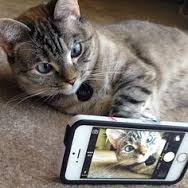 Research from one "cloud" company stated we upload more pictures of our cats than dogs. What does this actually say about cat guardians? Do we take more cat pictures because we're "cat crazy?" Jackie Stone from MiMedia has her reasons for the trend.
Research from one "cloud" company stated we upload more pictures of our cats than dogs. What does this actually say about cat guardians? Do we take more cat pictures because we're "cat crazy?" Jackie Stone from MiMedia has her reasons for the trend.
MiMedia, Inc., the next generation personal cloud for digital content, including photos, video, music, and documents, wanted to answer an age-old question - Who loves their pets more, dog or cat owners? They were also curious about pet owners' media sharing habits and how much storage space pet photos and videos take up on digital devices. MiMedia went out to seek the answers and what they found was pretty impressive.
Jackie Stone, the Chief Marketing Officer for MiMedia, told us that they did a survey of around 1,000 cat and dog lover users and came up with some pretty in interesting stuff!
Believe it or not, cat owners take up more gigabytes per year in their phone than dog owners. Cat owners take 4 to 5 pictures a day of their cats, while dog owners only take 2. However, dog owners take more videos. They take 2 videos of their dogs per week; where only about 7-percent of cat owners take 2 videos per week. While there is a difference between photos and videos, cat owners win all around with gigabyte storage.
 Jackie has owned both dogs and cats, and her personal view on this is that cats are more sedentary, so you have a much better photo opportunity than you do with dogs, which are more active.
Jackie has owned both dogs and cats, and her personal view on this is that cats are more sedentary, so you have a much better photo opportunity than you do with dogs, which are more active.
Cat and dog owners take so many photos and videos of their pets that collectively 40-percent admit to have run out of storage on smartphones.
Cat & Dog Stats:
- Talk about a pet peeve! 40-percent of both Cat and Dog owners have run out of storage on their smartphones
- A pet video a day eats the storage away - 2 pet videos per week at 11 seconds each equates to 1.14 GB per year
- Sharing is caring - 42-percent of all cat and dog videos/pictures that are taken are shared; 70-percent of pet photos are shared via text message
MiMedia is a service built exclusively for consumers that provides an elegant visual experience on a secure platform with easy organizational and private sharing features for family and friends in one spot - safe, organized and accessible always on iOS and Android mobile devices (smartphones and tablets), accessible via all web browsers and its desktop uploader allows users to easily upload content from any personal computer (PC or MAC).
Visit Website
Create New Life From The Life Of Your Beloved Pet
Remy Bibaud, Pet Perennials
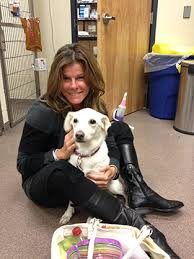 The one downfall of cats and dogs is their short life span. This leaves us looking for unique ways to pay tribute to their life. We've found companies that will turn your pet into a diamond gem stone or shoot your pet's remains into space. But there is also Pet Perennials, a wild-flower garden composed from your pet's ashes.
The one downfall of cats and dogs is their short life span. This leaves us looking for unique ways to pay tribute to their life. We've found companies that will turn your pet into a diamond gem stone or shoot your pet's remains into space. But there is also Pet Perennials, a wild-flower garden composed from your pet's ashes.
The team at Cherished Ones, the makers of Pet Perennials, understand fully the emotional, psychological and physical effects that losing a pet can have and have created a one of a kind, living memorial product.
The founders of Pet Perennials, Remy Bibaud and Lori Davidson, have both experienced this kind of loss, and their own experiences were the inspiration.
They were able to find a way to take a part of the cremated remains of a pet and create flower wafers, or seed wafers, which pet parents can grow and create perennial gardens.
To do this, they have a soil matrix that is pre-made with all of the necessary ingredients. You then have the option to add your pet's cremated remains to the soil matrix. Next, they merge perennial and annual wildflower seeds with the matrix and then cut them into many different shapes to signify our pets. These shapes can include hearts, dogs, flowers and paws.
They also have a do-it-yourself at home MiY Pet Perennials Kit. This lets you make your own flower wafers and allows you to decide whether or not you would like to add the cremains of your pet (about1/2 teaspoon) to the matrix and cut your own shapes. The seed wafers then can be used to start a flower garden or to dispense wherever you choose to create a living memorial.
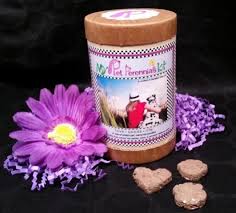 One custom order includes 24 wafers so you are not limited to when or where you place them. You can include family and friends in the celebration by giving them some of the seed wafers as well if they have moved away, or order them their very own batch. The MiY Pet Perennials Kit makes approximately 12 seed wafers. The wafers allow you to plant them anywhere you spent time with your pet. This could be a dog park or even a pasture where you would ride your horse.
One custom order includes 24 wafers so you are not limited to when or where you place them. You can include family and friends in the celebration by giving them some of the seed wafers as well if they have moved away, or order them their very own batch. The MiY Pet Perennials Kit makes approximately 12 seed wafers. The wafers allow you to plant them anywhere you spent time with your pet. This could be a dog park or even a pasture where you would ride your horse.
There is no "right" or "wrong" way to use Pet Perennials. The wafers are so easy to grow. You don't need to plant them; you just "sow" them by placing them on top of soil on the ground or in a flowerpot, water them and they will bloom. Please keep in mind that perennial seeds will take a year or two to "flower" from the time of sowing, however they will germinate within approximately 7 to 14 days along with the annual seeds.
Pet Perennials offer two wildflower seed mix options, the Butterfly Hummingbird perennial seed mix and the Pollinator perennial seed mix. Such a lovely way to celebrate the life of your pet.
Visit Website
It's Not Doggie Asthma - It's a Reverse Sneeze - Dr. Debbie
 What dog owner hasn't heard that frightening sound that dogs make - part cough, part sneeze and often described as a dog being unable to catch his breath. But it really isn't asthma, or some kind of bone stuck in your dog's throat - it's a reverse sneeze. So before you panic and run into the veterinary office on emergency, ensure you know what a reverse sneeze is.
What dog owner hasn't heard that frightening sound that dogs make - part cough, part sneeze and often described as a dog being unable to catch his breath. But it really isn't asthma, or some kind of bone stuck in your dog's throat - it's a reverse sneeze. So before you panic and run into the veterinary office on emergency, ensure you know what a reverse sneeze is.
Meet the Reverse Sneeze
A reverse sneeze is a respiratory sound in a category all its own. Also known as a pharyngeal gag reflex or backwards sneeze, the reverse sneeze is a commonly observed respiratory sound in dogs, and less commonly in cats. While a true sneeze occurs on the exhale, the reverse sneeze occurs as the dog inhales. The result is a reverberating snorting, wheezing, episodic sound that lasts for a few seconds to a minute or two. A reverse sneeze is a completely harmless sound and dogs do not suffer any immediate health threat from these episodes.
How can you tell it's a reverse sneeze?
There is no easy explanation of the sound - you just have to hear it and you'll recognize it. Click to see and hear an example of a dog's reverse sneeze episode.
Part of my enjoyment on the weekly national radio program, Animal Radio, is describing the peculiar smells, sounds and essences of veterinary medicine with our listeners. On many an occasion when speaking to callers, I have re-created the sounds of reverse sneezing. I'm no Rich Little, but I do take pride in my impersonation of a canine reverse sneeze, which is admittedly better in person with the visuals to complement the throaty sound.
Characteristics of a dog displaying a reverse sneeze include:
- Vibrational coughing/wheezing sound
- Stiff, extended neck
- Facial grimace
- No discharge from nose
- Not followed by coughing or vomiting up material
- Not involving collapse episodes
- Animal is completely normal after event
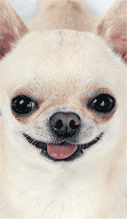 What causes a reverse sneeze?
What causes a reverse sneeze?
Some reverse sneeze episodes occur when a dog gets very excited or pulls against a leash. Brachycephalic breeds (short faced breeds) like Pugs and Boston terriers commonly display reverse sneezing due to their upper airway conformation.
Allergies, respiratory infections, nasal mites, inhaled foreign bodies and masses can also trigger reverse sneezing. Dogs with inflammatory conditions such as lymphoplasmacytic rhinitis can also display bouts of reverse sneezing. And sometimes reverse sneezing occurs in the wee hours of the night, while a dog is sleeping, for no apparent reason. In fact, many veterinarians receive panicked phone calls at 2am from pet owners, concerned of impending asthma attacks or respiratory arrest, only to have it turn out just to be a typical case of reverse sneezing.
What to Do?
There is no required treatment for a reverse sneeze episode. However, I recommend stroking a dog's throat while gently speaking to him in a calm manner until the episode subsides. Some advocate closing/pinching the nostrils off, which forces a dog to swallow and curtails the reverse sneeze episode. Whatever the approach, reverse sneezing episodes are over within minutes, so no emergency treatment is indicated. Antihistamines may be prescribed to minimize reverse sneezing episodes.
When to Worry?
If all of a sudden your dog is having repeated bouts of reverse sneezing, evaluation by your veterinarian is indicated. Consult with your veterinarian if your dog is reverse sneezing along with other symptoms such as facial rubbing, nasal bleeding, nasal discharge, coughing, or significant sneezing episodes.
Nasal mites are a common cause of reverse sneezing and may be noted after a recent boarding visit, especially if multiple dogs in a household are involved. Nasal mite treatment is easily pursued with anti-parasite injections of ivermectin (or in collie breeds - the alternative Milbemycin.) If reverse sneezing is excessive and prolonged, the nasal and pharyngeal areas should be evaluated by a veterinarian through rhinoscopy - a procedure performed under anesthesia in which the nasal passages and pharyngeal areas are visualized with an endoscope, a micro camera. This is how foreign objects and masses are typically identified. In other cases, further tests may be needed including a CT scan or with biopsy samples from sinus passages.
Final Thought
The good news is that most of reverse sneezing episodes are harmless, and do not indicate any serious illness. Arm yourself with information by learning what a reverse sneeze looks like and you may save yourself an unwanted emergency veterinary visit over this peculiar but non-life threatening occurrence.
Featured veterinarian known as "Dr. Debbie" on national pet radio program, Animal Radio. Ebook author of "Yorkshire Terriers: How to Be Your Dog's Best Friend"; "Pugs: How to Be Your Dog's Best Friend"; "Mini Schnauzers: How to Be Your Dog's Best Friend"; and "Shih Tzu: How to Be Your Dog's Best Friend." Dr. Debbie's books.
Visit Website
Animal Radio News - Lori Brooks
 The Differences Between Dog and Cat Owners
The Differences Between Dog and Cat Owners
Dog owners are happier, more sociable, earn bigger salaries and have a bigger sexual appetite than cat owners, according to a study. The data also suggested that dog owners were more likely to have paid off their mortgage and they were inclined to describe their job as "stressful." By contrast, cat owners are happier living alone and admit they relish a simpler pace of life. Dog owners are also enjoying life slightly higher up the career ladder. It also emerged that more cat owners live with their parents than dog owners. And that coincides with the fact feline fans are less likely to be married, 55-percent compared to 60-percent. Marked differences appeared in sociability too. Cat owners have an average of 50 online friends, while dog owners had 60. When asked to reveal how many "best friends" they had, cat owners had an average of 12, while canine lovers had 15 close friends. The study suggested dog owners also appeared to love their pets more, rating their affection at an average of 9.5 out of 10 compared to cat owners who came out at an average of 8 out of 10. It also emerged those who had canine companions enjoyed slightly more sex than their cat-loving counterparts, three times a week, to only twice for cat owners.
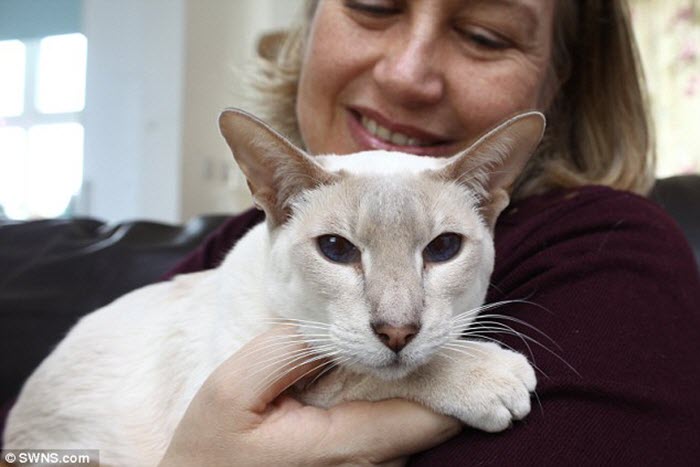 Cat Survived 8-Days Being Shipped in Box By Owner
Cat Survived 8-Days Being Shipped in Box By Owner
A Siamese was an incredibly lucky cat. The Siamese survived being stuck inside a small cardboard box for eight days and 260 miles after her owner accidentally mailed her. The owner didn't see her cat snoozing inside the package as she packed it with DVDs. Then she dropped the box in the mail. The package's recipients were stunned to open the box and find the cute cat curled up alongside the movies they'd bought. The cat was reunited with her tearful owner, who felt horrible. She said, " I knew my cat was missing, but not for one second did I think she was in that box." She said she put everything in the box and sealed it right away, and had no clue how her cat managed to get inside the package.
Could Your Clothing Be Made from Dogs or Cats?
Is your coat or part of your wardrobe made from dog or cat fur? Before you scramble to check the tag, know this: No one has to tell you if it is. This has been a problem around the world. In many countries animal advocates go as far as to plainly tell citizens not to wear any kind of fur, because even if it says it's fake or faux fur, real dog and cat fur-lined jackets have turned up in numerous police investigations, like Canada, where they seized knock-off parkas with German Shepard-lined hoods.
 If You Have a Cat - Get Rid of the Food Bowl
If You Have a Cat - Get Rid of the Food Bowl
Veterinary science has long known that cats should not be eating from bowls, according Dr. Liz Bales, a graduate of University of Pennsylvania School of Veterinary Medicine. In nature, cats catch their prey, play with it, eat it, groom themselves and sleep. They do this 9-20 times within a 24-hour cycle. Bales says, quite simply, hunting is a very important part of a cat's physical and mental health and that by putting cat food in bowls, owners inadvertently eliminate the natural bursts of energy cats require to maintain optimum health. The end result? Bowl feeding results in obesity, lethargy, aggressive behavior and scarf-and-barf syndrome where cats eat too quickly, then throw up. So, Bales designed the No-Bowl Feeding System that mimics nature. Instead of bowls, she created washable, portion-controlled kibble dispensers to be hidden around the house so that cats are engaged in an active form of hunting and playing with their food throughout the day and night.
 Listen to the entire Podcast of this show (#1216)
Listen to the entire Podcast of this show (#1216)





